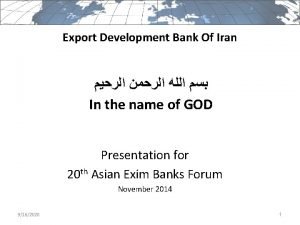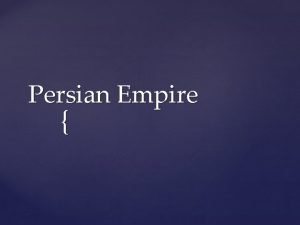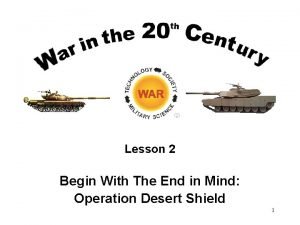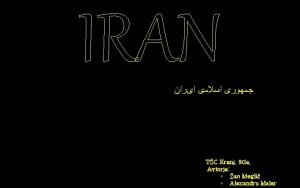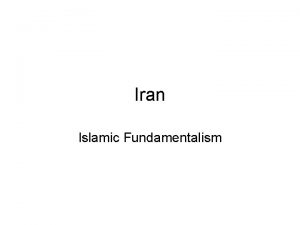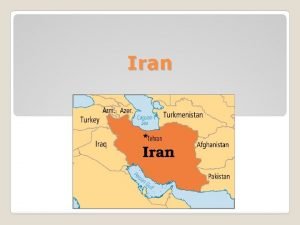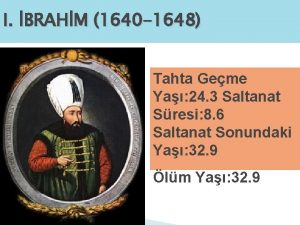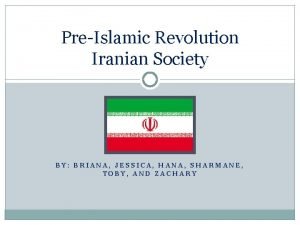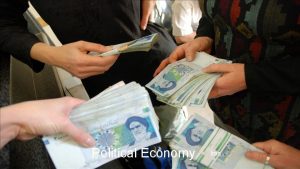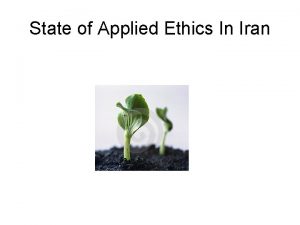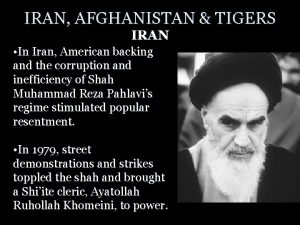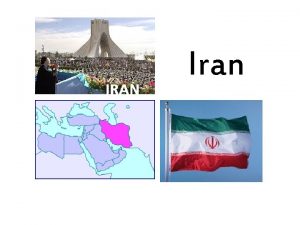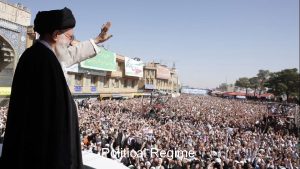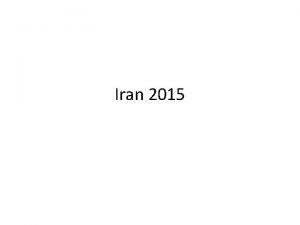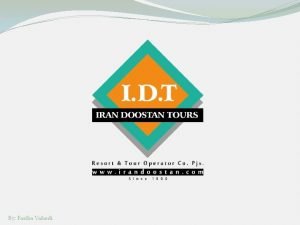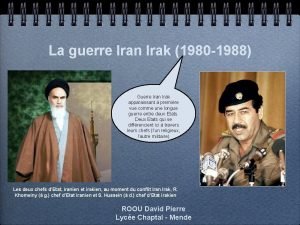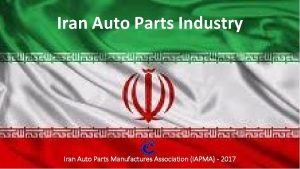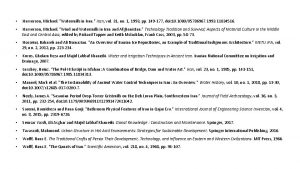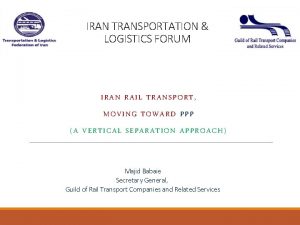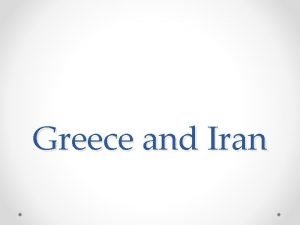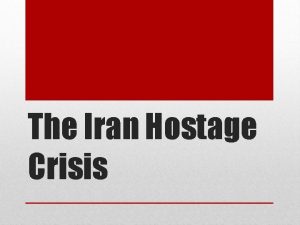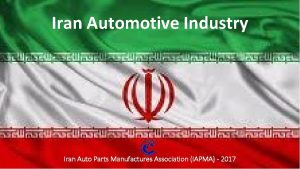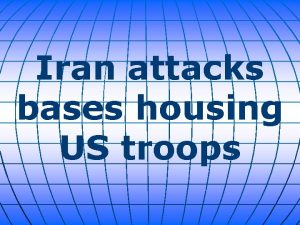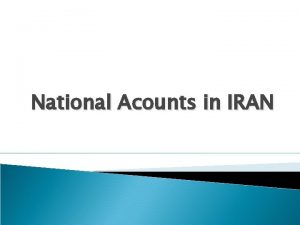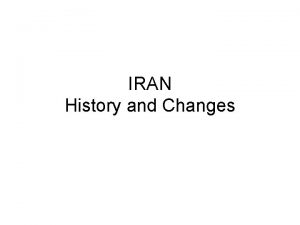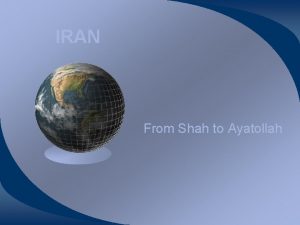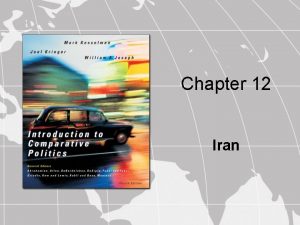Development of the State Iran Iran intro What


















































- Slides: 50

Development of the State Iran

Iran intro What in the past has shaped today’s Iranian politics?

What makes it special? Iran

Iran Islamism Uniqueness A belief that I literal interpretation of the faith should be the basis for the regime It’s a theocracy where a religious elite dominate the regime In the Islamic Republic, law and politics are expected to flow from the Koran This has become an inspiration for Islamist movements around the world.

Iran Isolation Uniqueness Iran is not an Arab country, the major ethnicity is Persian They speak Farsi, as opposed to Arabic – the common language of Middle East Iranians view themselves as distinct, looking upon Arab countries as foreign They practice Shiism – which only makes up about 10% of Islam.

Iran Domestic Politics Uniqueness Reformists sought to liberalize institutions, electing Mohammad Khatami in 1997. Conservatives sought to limit reforms, electing Mahmoud Ahmadinejad in 2005 In 2013, Hassan Rouhani was elected, promising to resume reforms. Reformists tend to improve relations with the West, while conservatives tend to be more confrontational. Reformists are limited in actual reform by the conservative religious institutions.

Iran Geography On the eastern periphery of the Middle East, bordering Afghanistan and Pakistan Smaller than Mexico, with a population of about 80 million people. Top 20 in size and population Has 4 th largest oil reserves & 2 nd largest natural gas reserves in the world. Oil has kept the current regime in power but has kept the rest of the economy stagnant.

Iran Population Geography Median age is 27 – much of the country was born after the 79 Revolution Younger populations want education, employment, and housing, which the government struggles to provide. Population is also diverse – only 60% is Persian. 20% is Azeri, then smaller groups Some groups practice Sunni Islam rather than Shia Islam. There are sporadic ethnic tensions, particularly among the Kurds.

Persia Iran

Iran Persia The Achaemenid Empire stretched from India across the Middle East in the first millennium BCE Led by Cyrus, Darius, and Xerxes – the empire grew & conquered neighbors Persia was known for its religious and political tolerance. The empire is still an important symbol of Iranian strength today.

Iran Islam Persia In the 600 s, Islam spread to the region, brought by Arab traders from the Middle East. The Umayyad dynasty brought Persia into the larger Islamic world. Arabic became the language of state and religion. The people continued to speak Farsi. The population gradually converted from Zoroastrianism to Islam It remained a part of the larger Islamic world until conquered by the Mongols

Dynasties & Shiism Iran

Iran Shia Islam Safavids The Safavids adopted Shiism to differentiate their country from the Ottoman Turks who were their Sunni rivals In Shia Islam, the imams are the true leaders of the faith. The “hidden imam”, the Madhi, is expected to reappear at the end of time to restore justice and quality to a corrupted world. This belief makes worldly politics secondary to the faith

Iran Hussein Safavids Shia venerate Hussein – Muhammad’s grandson – who carried out an uprising against the Umayyads Hussein & his family were killed at Karbala (in modern Iraq) by the Umayyads. Ashura – the most important Shia religious holiday – commemorates his death. Contemporary struggles are viewed in the context of his martyrdom – people feel the need to live up to his standards.

Iran Ayatollahs Safavids Shiism has been connected directly to politics in Iran for a long time. The Safavids created ayatollahs from within Shiism’s religious leaders. Ayatollahs are sometimes compared to bishops in Roman Catholicism The clergy of Shiism play a critical role in modern Iranian politics Ayatollahs inside & outside of Iran have their own followers and issue their own fatwas (religious rulings) Iran has a “supreme leader” but there is no “Shia pope”

Iran Safavids lost control of Iran in early 1700 s. Qajars ruled from 1794 -1925 Persia came under pressure from expanding neighbors. By mid 1800 s it was having to reform and confront the West. Russia was taking territory from the north and the UK had conquered India and was trying to control Afghanistan

Failed Reforms Iran

Iran Qajar End Reforms Last decades of Qajar dynasty, the monarchy attempted reforms They experimented with Western and political institutions Each attempt at reform would cede more sovereignty over to the British & Russians People saw the government as weak and the monarchy as selling off the country to Westerners.

Iran Majlis Reforms In 1906, the Constitutional Revolution called for limits on the monarchy The Majlis was created as an elected assembly & it wrote the first constitution It was an attempt at a republic, but the only clear goal was weakening the monarchy. Some goals were secular which caused conflicts with the ayatollahs Fighting between secularists & religious leaders allowed the UK & Russia to divide the country into spheres of influence

Iran British Reforms In WW 1, they were entangled in conflict between British, Russian, German, and Ottoman empires. Following WW 1, the German, Russian, & Ottoman empires collapsed leaving the UK in occupation of much of the country The Majlis was a constant opposition force against British imperialism Modern Iranian history is connected to British imperialism in this way – Iranian animosity toward Britain continues today

Pahlavi Dynasty Iran

Iran Coup Reza Kahn had risen through the ranks of Iran’s military In 1921, he led a coup in Tehran and consolidated power The UK did not plan the coup, but was happy to have a military strongman establish control of the country. From the outset, most Persians considered the coup to be the result of an imperialist plot. At the same time, Persians saw the US as an important supporter of Persian independence

Iran Pahlavi Reza Kahn renamed himself Reza Shah Pahlavi He proved to be basically a puppet of the British. He removed his co-conspirators from office, consolidated his power, and centralized the military In 1923, the last Qajar shah appointed him prime minister & the Majlis formally ended the Qajar dynasty Pahlavi was made new shah which pleased the clergy who were opposed to creation of a secular republic.

Iran Pahlavi Reza Shah Pahlavi was a monarch with almost no restraints on his power He pursued a course of dramatic Westernization He reformed the bureaucracy, created an education system, developed road & rail, and developed state owned enterprises to control resources. He exerted some control over the oil industry which UK had dominated

Iran Nationalism Pahlavi He implemented national conscription to extend Iran’s military might. He promoted the idea of a single national identify whose people’s glory went back thousands of years The name Pahlavi tied him to pre-Islamic Persia His rule helped foster a strong sense of national identity. His changed the name of Persia to Iran (Persia was the foreign name, Iran was used by its inhabitants)

Iran Women Pahlavi He improved the rights of women during his rule Women were given access to the education system, including college In 1934, he forbade the wearing of head coverings in public These reforms for women were seen by some as part of a bigger attack on Shiism

Iran Civil Society Pahlavi Religious and political opponents were jailed, exiled, or killed Democratic institutions like the press & Majlis were curtailed The power of the clergy was also limited as the state set more social norms Leading up to WW 2, Iran had established modern political institutions – but progress came at cost of repressed civil society

Iran WW 2 Pahlavi Iran had good relations with Germany, which made UK & USSR intervene UK & USSR invaded Iran to keep its oil out of Germany’s hands Reza Shah was forced to abdicate and his son Mohammad Reza Pahlavi took over The country was weakened which allowed political and religious activity to resurface while US & USSR fought for influence after WW 2

Mosaddeq Iran

Iran Mohammad Reza Pahlavi Mosaddeq Mohammad Reza was unable to stop the advances of renewed democratic and religious activity The Majlis & religious leaders promoted the removal of Western influence Many supported the nationalization of the oil industry A new party, the National Front, gained majority which made Mohammad Mosaddeq the prime minister

Iran Mosaddeq advocated nationalization of resources, particularly oil He also called for reducing the power of the monarchy or even eliminating it The shah reluctantly agreed to nationalize the oil in 1951. The British were angry and withdrew all technical support, which brought production to a halt. Nationalization created animosity with the British & his modernization alienated the religious leaders.

Iran Operation Ajax Mosaddeq also made allies with the Tudeh Party which was Marxist His alliance with Tudeh raised fears in the US of a communist Iran The shah supported the US in overthrowing Mosaddeq with the CIA The National Front & Tudeh leaders were arrested and some were executed Mosaddeq was placed under house arrest until he died in 1967 Religious leaders welcomed Mosaddeq’s overthrow

Iran Shah returns Mosaddeq’s overthrow led to the shah reconsolidating power in Iran The shah worked to develop an Iran independent of Western power but also worked toward a new alliance with the United States He repressed opposition with a new secret police force, the SAVAK He also took power from the prime minister & the Majlis This ended the short period of democracy in Iran and its destruction became associated with the US.

White Revolution Iran

Iran Opposition White Revolution After gaining total control, the shah revived his dad’s policies of reform in 1963 Modernization included land reform, literacy campaigns, privatization of SOEs, and voting for women. Many of these proposals were opposed by religious leaders. Protests and rioting broke out which were suppressed violently. Ruhollah Khomeini was an ayatollah who encouraged the protests and stood in opposition to the shah

Iran Khomeini White Revolution Khomeini was known for his writing that worldly politics were linked to religion These ideas set him about from most Shia clerics, but he rose to the rank of Grand Ayatollah The shah exiled him and he settled in Iraq and France, but continued his criticism He called for an Iran governed by Islam A religious alternative gained support because of the failures of democracy

Iran White Revolution From 1963 -1979 the shah ruled without any serious challenges The state had total power concentrated in the monarchy that was enforced by the SAVAK Rising oil revenues funded rapid modernization reforms Over this period tens of thousands of Americans moved there to work, which generated social change & resentment A middle class emerged in Iran but it did not feel the benefits of modernization The oil industry was directed and run by foreigners (US) again

Iranian Revolution Iran

Iran Late 1970 s In the late 1970 s, Iran’s economy declined while state repression increased. Jimmy Carter criticized the shah in an effort to promote human rights. The shah carried out more reforms in response National Front was allowed to organize again. The US backed off. The main source of outside opposition to the shah became Khomeini again

Iran Khomeini advocated for velayat-e faqih, or clerical rule – monarchy was a usurpation of Allah’s rule on earth. A system of govt by a clergy trained in Islamic law would be a continuation of the political system first established by the prophet Muhammad The clergy would serve in place of the Madhi until he returned He advocated for the overthrow of the shah since this was the only type of govt consistent with the will of Allah His writings began attracting larger followings & his popularity grew.

Iranian Revolution 1978 In 1978 the shah attempted a smear campaign against Khomeini but it only increased support for him Protests erupted and the govt responded harshly again A fire killed 400 & many blamed SAVAK for starting the fire (it was Islamic radicals) The shah declared martial law. Protests called for the end of monarchy and the return of Khomeini The shah persuaded the Iraqis to move Khomeini to France (which gave him more access to international media)

Iran Revolution Iranian Revolution Tehran was overcome with political violence & shah’s power was slipping The US criticized the violent response Military units began to defect and the shah fled Iran A provisional govt was put in place and Ayatollah Khomeini was allowed to return to Iran February 1, 1979 Many expected a democratic republic to replace the monarchy

Islamic Republic Iran

Iran Khomeini Islamic Republic Khomeini used his charismatic authority to undermine the secular provisional govt. He gained control of the govt and oversaw the drafting of a constitution It allowed for a president and prime minister but also a faqih (religious leader) who would have supreme authority Khomeini assumed this position and held it until his death in 1989

Iran Islamic Republic The Islamic Republic immediately suppressed all opposition, including monarchists, Marxists, and secularists as well as ethnic minorities & other religions Student radicals seized the US embassy and held its staff hostage for over a year. President Carter attempted a rescue that failed – which ended diplomatic relations between the two countries.

Iran -- Iraq War Iran – Iraq War Saddam Hussein, leader of Iraq, saw this as a threat to his rule – because Iraq had so many Shiite Muslims. Iraq launched an invasion in 1980 to try to extend power & seize Iranian territory Iraq had the support of the US and most of the Arab world Iranians rallied to defend the homeland – which institutionalized the revolution Hussein tried to end the war in 1982 but Khomeini refused – framing the war as part of a greater struggle for Muslims

Iran Aftermath Iran – Iraq War Iraq used chemical weapons and Iran exhausted its entire military force The war ended in stalemate in 1988 Nearly a million people died Khomeini died a year later, leaving the Islamic Republic without its founder

Iran Ali Khamenei Was president throughout the 1980 s, made supreme leader in 1989. Was not an ayatollah but the constitution said the supreme leader must be The constitution was revised and he was promoted to ayatollah to become supreme leader after Khomeini’s death Khamenei lacked the charismatic power of Khomeini or the religious authority of Iran’s senior clerics. He has consolidated his power by making alliances with religious leaders and the military

Ayatollah’s Advice Iran

Main Ideas Iran Impact of Shiism Pahlavi dynasty Mosaddeq & the West Rise of Khomeini Ayatollah’s Advice
 Export development bank of iran
Export development bank of iran Hình ảnh bộ gõ cơ thể búng tay
Hình ảnh bộ gõ cơ thể búng tay Slidetodoc
Slidetodoc Bổ thể
Bổ thể Tỉ lệ cơ thể trẻ em
Tỉ lệ cơ thể trẻ em Chó sói
Chó sói Tư thế worm breton
Tư thế worm breton Chúa yêu trần thế
Chúa yêu trần thế Kể tên các môn thể thao
Kể tên các môn thể thao Thế nào là hệ số cao nhất
Thế nào là hệ số cao nhất Các châu lục và đại dương trên thế giới
Các châu lục và đại dương trên thế giới Công thức tính thế năng
Công thức tính thế năng Trời xanh đây là của chúng ta thể thơ
Trời xanh đây là của chúng ta thể thơ Mật thư tọa độ 5x5
Mật thư tọa độ 5x5 Làm thế nào để 102-1=99
Làm thế nào để 102-1=99 độ dài liên kết
độ dài liên kết Các châu lục và đại dương trên thế giới
Các châu lục và đại dương trên thế giới Thơ thất ngôn tứ tuyệt đường luật
Thơ thất ngôn tứ tuyệt đường luật Quá trình desamine hóa có thể tạo ra
Quá trình desamine hóa có thể tạo ra Một số thể thơ truyền thống
Một số thể thơ truyền thống Cái miệng bé xinh thế chỉ nói điều hay thôi
Cái miệng bé xinh thế chỉ nói điều hay thôi Vẽ hình chiếu vuông góc của vật thể sau
Vẽ hình chiếu vuông góc của vật thể sau Biện pháp chống mỏi cơ
Biện pháp chống mỏi cơ đặc điểm cơ thể của người tối cổ
đặc điểm cơ thể của người tối cổ Thế nào là giọng cùng tên? *
Thế nào là giọng cùng tên? * Vẽ hình chiếu đứng bằng cạnh của vật thể
Vẽ hình chiếu đứng bằng cạnh của vật thể Vẽ hình chiếu vuông góc của vật thể sau
Vẽ hình chiếu vuông góc của vật thể sau Thẻ vin
Thẻ vin đại từ thay thế
đại từ thay thế điện thế nghỉ
điện thế nghỉ Tư thế ngồi viết
Tư thế ngồi viết Diễn thế sinh thái là
Diễn thế sinh thái là Dạng đột biến một nhiễm là
Dạng đột biến một nhiễm là Bảng số nguyên tố
Bảng số nguyên tố Tư thế ngồi viết
Tư thế ngồi viết Lời thề hippocrates
Lời thề hippocrates Thiếu nhi thế giới liên hoan
Thiếu nhi thế giới liên hoan ưu thế lai là gì
ưu thế lai là gì Sự nuôi và dạy con của hươu
Sự nuôi và dạy con của hươu Sự nuôi và dạy con của hổ
Sự nuôi và dạy con của hổ Sơ đồ cơ thể người
Sơ đồ cơ thể người Từ ngữ thể hiện lòng nhân hậu
Từ ngữ thể hiện lòng nhân hậu Thế nào là mạng điện lắp đặt kiểu nổi
Thế nào là mạng điện lắp đặt kiểu nổi Satrapy of iran
Satrapy of iran Iran hostage crisis timeline
Iran hostage crisis timeline Kranj prebivalstvo
Kranj prebivalstvo Persian cat map
Persian cat map What was iran known as before 1935?
What was iran known as before 1935? Iran'la sınırımızı belirleyen antlaşma
Iran'la sınırımızı belirleyen antlaşma William knox d'arcy
William knox d'arcy Jessica hana
Jessica hana
